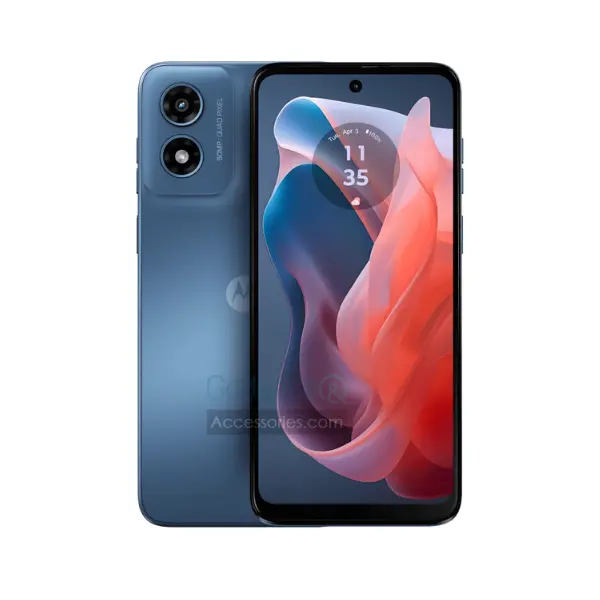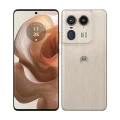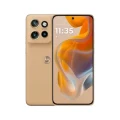Motorola Moto G Play (2024)

Motorola Moto G Play (2024) - Specifications
General
| Device Type | Smart Phone |
| Model | N/A |
| Announced | 16 January, 2024 |
| Release Date | 26 January, 2024 |
| Estimated Price | $130 to $200 |
Network
| 2G Network | GSM 850 / 900 / 1800 / 1900 |
| 3G Network | HSDPA 850 / 900 / 1700(AWS) / 1900 / 2100 |
| 4G Network | 1, 2, 3, 4, 5, 7, 8, 12, 13, 17, 25, 26, 28, 38, 41, 66, 71 - USA |
| SIM SIM (Subscriber Identity Module) is a small card that contains mobile network subscriber's account information. This allows the phone using the card to attach to a mobile network. The SIM card is most commonly associated with GSM and UMTS mobile networks. Moving a SIM card from one phone to another allows a subscriber to switch mobile phones without having to contact their mobile network carrier. SIM cards can also be used by a phone to store limited amounts of data, such as phone numbers and text messages. | Nano-SIM Water-repellent design |
| Dual SIM | No |
| eSIM | No |
Camera
| Primary Camera is able to capture photographs and usually videos, The most important characteristics of a camera are the resolution (measured in megapixels), lens focus type (fixed or automatic), higher megapixel cameras are known to capture higher quality photos, but not always a good measurement of the photos quality. | 50 MP, f/1.8, (wide), 0.64µm, PDAF |
| Video | 1080p@30fps |
| Camera Features | LED flash, HDR, panorama |
| Built-In Flash Flash Light => There is commonly two types of flash lights are used in camera mobile phones, LED Flash (LED flash offers lower power consumption with drive circuitry that takes up very little room, LEDs can be strobed faster than any other light source), Xenon Flash (xenon flash produces an extremely intense full-spectrum white light for a very short duration) | Yes |
| Secondary | 8 MP, f/2.0, (wide), 1.12µm |
Display
| Display Type Display Technology => A number of display technologies and types used in mobile phones => TFT (Thin Film Transistor), IPS (In-Place Switching), OLED (Organic Light Emitting Diode), AMOLED (Active-Matrix Organic Light-Emitting Diode), Super AMOLED (an even advanced version of AMOLED), Resistive Touchscreen (Resistive touchscreens contain two layer of conductive material with a very small gap between them which acts as a resistance), Capacitive Touchsceen (Capacitive touchscreen technology consists of a layer of glass coated with a transparent conductor) | IPS LCD, 90Hz, 500 nits (typ) |
| Size | 6.5 inches, 102.0 cm2 (~83.0% screen-to-body ratio) |
| Touch Screen | Multi-touch |
| Resolution | 720 x 1600 pixels, 20:9 ratio (~270 ppi density) |
| Display Colors Display Colors is refers to the number of different shades of colors that the screen is capable of displaying => 64K colors, 256K colors and 16 million colors, Obviously 16M is highest available range of colors and better than others. | 16M Colors |
| Pixel Density Pixel Density (PPI) is refers to the concentration of pixels on a particular display, measured in pixels per inch (ppi). Pixel density is calculated by dividing the diagonal pixel resolution of a display by its diagonal size, higher pixel density better display quality. | (~270 ppi density) |
| Display Protection Display Protection => Gorilla Glass is a special alkali-aluminosilicate glass shield with exceptional damage resistance that helps protect mobile displays from scratches, drops, and bumps of everyday use, It is always better to go for a smartphone with Gorilla Glass for that added protection and peace of mind. | Corning Gorilla Glass 3 |
Design
| Dimensions | 163.8 x 75 x 8.3 mm (6.45 x 2.95 x 0.33 in) |
| Weight | 185 g (6.53 oz) |
| Protection | Glass front, plastic frame, plastic back |
| Colors | Sapphire Blue |
Media
| Radio | No |
| Loudspeaker | Yes, with stereo speakers |
Software
| Operating System OS => Every computer system run on a base software called Operating System (OS). Operating System controls all basic operations of the computer (such as smartphone, PDAs, tablet computers and other handheld devices). The Operating System allows the user to install and run third party applications (apps), apps are used to add new functionality to the device. | Android 13 |
Hardware
| Chipset Chipset is a group of integrated circuits designed to perform one or a more dedicated functions, often with real time computing constraints, Popular smartphones are equipped with more advanced embedded chipsets that can do many different tasks depending on their programming. | Qualcomm SM6225 Snapdragon 680 4G (6 nm) |
| CPU CPU (Central Processing Unit) mostly known as processors, CPU processes instructions in order to carry out certain functions that make your device operate properly. Processors are often described as the brain of computers, smartphones and tablets, Smartphones and tablets rely on processors to carry out their every task, Processors are an incredibly important factor in selecting any type of computing device, including your smartphone. | Octa-core (4x2.4 GHz Kryo 265 Gold & 4x1.9 GHz Kryo 265 Silver) |
| GPU GPU (Graphics Processing Unit) is a single-chip processor designed to rapidly manipulate and alter memory to accelerate the creation of images in a frame buffer intended for output to a display, This includes things such as lighting effects, object transformations, and 3D motion. | Adreno 610 |
| RAM (Memory) RAM (Random Access Memory) is a type of computer memory that can be accessed randomly, any byte of memory can be accessed without touching the preceding bytes that allows information to be stored and accessed quickly from random locations. RAM is the most common type of memory found in computer systems, smartphones, tablets and other electronic devices. | 4GB |
| Internal Storage Internal Storage is a data storage space (flash memory) mostly used in smartphones, tablets and other electronic devices where operating system, apps, music, photos, videos, files and other user data Is stored. | 64GB |
| Card Slot Memory Card Slot is a special slot for inserting a memory card. Memory cards allow you to expand the phone's built-in memory, A memory card (sometimes called a flash memory card or a storage card) is a small storage medium used to store data such as text, pictures, audio, and video, for use on small, portable or remote computing devices such as mobile phones, mp3 players, digital cameras. | MicroSDXC (dedicated slot) |
| Sensors Sensors are electronic components that detects and responds to some type of input from the physical environment. The specific input could be light, heat, motion, moisture, pressure and location, The output is generally a signal that is converted to use in computing systems, a location sensor, such as a GPS receiver is able to detect current location of your electronic device. | Fingerprint (side-mounted), accelerometer, proximity, compass, barometer |
Connectivity
| Bluetooth Bluetooth is a wireless communications technology for exchanging data between mobile phones, headsets, computers and other network devices over short distances without wires, Bluetooth technology was primarily designed to support simple wireless networking of personal consumer devices. | 5.1, A2DP, LE |
| Infrared Infrared connectivity is an old wireless technology used to connect two electronic devices. It uses a beam of infrared light to transmit information and so requires direct line of sight and operates only at close range. | |
| Wi-fi Wi-Fi is a popular wireless networking technology using radio waves to provide high-speed network connections that allows devices to communicate without cords or cables, Wi-Fi is increasingly becoming the preferred mode of internet connectivity all over the world. | Wi-Fi 802.11 a/b/g/n/ac, dual-band |
| Wi-fi Hotspot | |
| USB | USB Type-C 2.0 |
| GPS GPS The Global Positioning System is a satellite-based radio navigation system, GPS permits users to determine their position, velocity and the time 24 hours a day, in all weather, anywhere in the world, In order to locate your position, your device or GPS receiver must have a clear view of the sky. | GPS, GALILEO, GLONASS |
| NFC NFC (Near field communication) is a set of standards for smartphones and similar devices to establish peer-to-peer radio communications with each other by touching them together or bringing them into proximity, usually no more than a few inches. | |
| HDMI HDMI (High-Definition Multimedia Interface) is a compact audio/video interface for transferring uncompressed video data and compressed or uncompressed digital audio data from a HDMI-compliant source device to a compatible computer monitor, video projector, digital television, or digital audio device. | |
| Wireless Charging Wireless Charging (Inductive Charging) uses an electromagnetic field to transfer energy between two objects. This is usually done with a charging station. Energy is sent through an inductive coupling to an electrical device, which can then use that energy to charge batteries or run the device. | N/A |
Data
| GPRS GPRS (General Packet Radio Service) is a packet oriented mobile data service on the 2G and 3G cellular communication system's global system for mobile communications (GSM), Generally, GPRS is used for the purpose of wireless data transfer, such as sharing pictures and videos or browsing the Internet via a mobile phone connection. | |
| EDGE EDGE (Enhanced Data GSM Environment) is a wireless network technology generally considered the next step in the 2G network offers data transfer rates up to four times faster than ordinary GSM networks, Generally, EDGE is used for the purpose of wireless data transfer, such as sharing pictures and videos or browsing the Internet via a mobile phone connection. | |
| Speed | HSPA, LTE |
| Web Browser Web Browser => a web browser is a software application used to locate, retrieve and display content on the World Wide Web, including Web pages, images, video and other files, The primary function of a web browser is to render HTML, the code used to design or markup webpages. | HTML5 |
Messaging
| SMS SMS (Short Messaging Service) is a text messaging service component of phone, Web, or mobile communication systems. It uses standardized communications protocols to allow mobile phone devices to exchange short text messages over the networks. | Yes (threaded view) |
| MMS MMS (Multimedia Messaging Service) is a standard way to send messages that include multimedia content (audio clips, video clips and images) to and from mobile phones over wireless networks using the WAP protocol. | |
| Email Email (Electronic Mail) is a system for receiving, sending, and storing electronic messages, Similar to a letter, email is text messages that may contain files, images, or other attachments sent via the internet to a recipient by using applications and software prograps. An email address is required to receive email, and that address is unique to the user. | Yes |
| IM IM (Instant Messaging) is an exchange of text messages through a software application, it enable you to create a kind of private chat room with another individual in order to communicate in real time over the Internet. | Yes |
Battery
| Battery Type Battery Type => Cell phones run on various kinds of batteries depending on the manufacturer, phone size or shape and features. There are basically four types of cell phone batteries => Lithium Polymer, Lithium Ion, Nickel Metal Hydride and Nickel Cadmium. | Li-Po |
| Capacity Battery Capacity is a measure (typically in Amp-hr) of the charge stored by the battery, and is determined by the mass of active material contained in the battery. The battery capacity represents the maximum amount of energy that can be extracted from the battery under certain conditions. | 5000 mAh |
| Placement | Non-Removable |
| Charging | 15W wired |
Motorola has launched the Moto G Play (2024), the latest addition to its affordable Moto G series. The Motorola Moto G Play (2024) price in Pakistan starts from Rs. 42,600. The Motorola Moto G Play (2024) has 4GB RAM and 64GB Storage with Android 13 and comes in Sapphire Blue colors.
This budget-friendly smartphone offers significant improvements compared to its predecessor, including the upgraded Qualcomm Snapdragon 680 SoC for better performance and efficiency. The new model has undergone various enhancements, and we will now delve into the specifics of this mobile phone.
Display & Design
The Moto G Play (2024) has a 6.5-inch 90Hz display with slightly wider bezels. It has a matte texture on the back and is available in a sapphire color. The waterproof device has three buttons on the right side for power and volume control.
The SIM card tray is located on the left side. The device has rounded edges, giving it an elegant look. It has a single punch-hole on the front for the selfie camera, and the Motorola logo is in the center on the back. The camera module also has rounded edges, matching the phone’s overall design.
Camera
The primary phone’s main camera has been improved to a 50MP sensor, improving image quality. It can shoot video at either 1080p or 720p at 30fps. This is a significant upgrade from the previous 16MP camera. Using pixel binning technology allows for sharper images even at lower resolution. Additionally, the phone includes HDR and phase detection autofocus features to enhance the overall shooting experience.
The primary camera also supports 8x digital zoom, quad-pixel tech, HDR, and phase detection autofocus. It also supports various shooting modes, including night vision, Portrait, Live Filters, Panorama, Pro Mode (w/ Long Exposure), Dual Capture Photo, Burst Shot, and more. The front camera has also been upgraded to 8MP, supporting Google Lens integration and AI-powered smile detection.
Sound
The Moto G Play (2024) has Dolby Atmos stereo speakers with excellent sound quality. Users can use Dolby Atmos to enhance their listening experience through the phone’s speakers. They can choose from various proper profiles, like music, movies, games, or podcasts, to customize their audio experience.
Connectivity
The Motorola Moto G Play (2024) does not have 5G capabilities, which is a drawback for this budget phone. However, it does support 4G LTE connectivity and Wi-Fi networks.
The phone can automatically connect to previously used Wi-Fi networks, allowing users to search and connect to available networks by entering a password or scanning a QR code. Additionally, it supports Bluetooth 5.0 for connecting to accessories.
Storage
The Motorola Moto G Play (2024) offers a range of internal storage options, 4GB/ 64GB, allowing users to choose the variant that suits their storage requirements. This is especially advantageous for those who heavily depend on their smartphones for work, entertainment, and capturing essential memories, as it provides ample space for apps, photos, videos, and more.
Battery
The Motorola Moto G Play (2024) has a 5000mAh battery, which is impressive for an entry-level device. It can last 46 hours on one charge, although shorter than the previous generation. The charging speed has also been improved from 10W to 15W, but the box still includes a 10W charger.
Conclusion
The Motorola Moto G Play (2024) stands out in a crowded smartphone market due to its impressive storage capabilities. It offers a good balance between internal storage options and the ability to expand storage with a microSD card slot, making it an excellent choice for users with diverse storage needs.
Whether you need a phone for work or content creation or want a reliable device with plenty of space for personal files, the Moto G Play (2024) is worth considering. Motorola is known for providing quality devices at an affordable price, and the Moto G Play (2024) is a strong competitor in the smartphone industry.
Moreover, the phone will be available to buy online soon on websites like OLX, Daraz, and PriceOye. You can also find it in other popular online stores in Pakistan. For the latest phones, smartwatches, and tablets, check out the best deals, coupons, offers, comparisons, reviews, and more!!!










